 image by Ivan Sache, 28 July 2018
image by Ivan Sache, 28 July 2018
Last modified: 2024-02-24 by rob raeside
Keywords: education |
Links: FOTW homepage |
search |
disclaimer and copyright |
write us |
mirrors
See also:
Other Institutions:
 image by Ivan Sache, 28 July 2018
image by Ivan Sache, 28 July 2018
Institución Educativa Blanca Duran de Padilla was established on 5 May 1075
in El Centro, Barrancabermeja (Santander).
The flag of IE Blanca Duran de
Padilla is described in the school's Manual de Convivencia as follows;
The flag is composed of two horizontal rectangles of equal size, the one yellow
and the other green.
Yellow represents the resources of the region and the
values defended by the parents and teachers through education and guidance.
Green means the youth's hope and dreams' realization.
http://www.blancaduran.edu.co/phocadownload/2015_MANUAL_DE_CONVIVENCIA.pdf
Manual de Convivencia
Ivan Sache, 28 July 2018
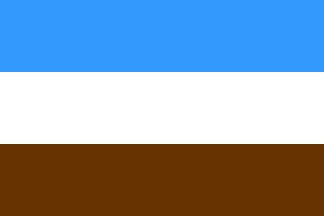 image by Ivan Sache, 14 November 2010
image by Ivan Sache, 14 November 2010
I recently wrote that the Colombian Theresian educational institutes could
share a common flag, horizontally divided white-blue. My assumption, based on
two samples, was erroneous.
Colegio Teresiano de Bogotá is one of the seven Colombian institutes chaired by
the Community of St. Therese of the Child Jesus. It was founded on 12 February
1962 and officially registered on 9 September 1963.
The flag of Colegio Teresiano de Bogotá is presented on the institute's website
as horizontally divided light blue-white-coffee brown. Coffee brown represents
the Earth and the soil. Light blue represents transcendence of the infinite, the
mystery of cosmos, the metaphysical dimension of reality. White, placed between
the two other colors, represent the Earth and Heavens, the finite and infinite,
the immanent and the transcendent.
Source:
http://www.teresianobogota.edu.co/quienes.htm
Ivan Sache, 14 November 2010
 image by Ivan Sache 1
January 2021
image by Ivan Sache 1
January 2021
Colegio Bolívar was established in 1942 in Soacha (Cundinamarca) by parish
priest Manuel Vicente Rojas.
The flag of Colegio Bolívar is horizontally
divided blue-gray-blue with the school's coat of arms in the center.
Blue is
a symbol of tranquility, welfare and seriousness
Gray is a symbol of
sobriety, respect of difference, balance and harmony.
The coat of arms
features the Bible as a source of knowledge, wisdom and direction.
The
writing is taken from John 8:32: "Then you will know the truth, and the truth
will set you free."
https://www.colegiobolivarsoacha.edu.co/index.php/nuestro-colegio/nuestra-identidad
School website
Ivan Sache 1 January 2021
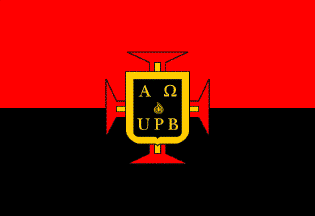 image by Ivan Sache, 28 December 2008
image by Ivan Sache, 28 December 2008
Flag of UPB is based on <www.upb.edu.co>.
Dov Gutterman, 3 June 2001
"Universidad Pontificiana Bolivariana" (UPB) is a
Roman Catholic institute, recognized "ab homine" by the
Archbishop of Medellín Tiberio de J. Salazar y Herrera on 15
September 1936, and subsequently recognized by the Government of
Colombia on 22 February 1937 (Decree No. 48). The university was
upgraded to a "Pontificia" by the Holy Congregation of
Seminaries and Universities on 16 August 1945. UPB has its main
seat in Medellín and secondary seats in Bucaramanga, Montería
and Palmira.
The flag of UPB, as shown graphically and described on the UPB
website, is horizontally divided red-black with the emblem of
UPB in the middle.
Red represents charity while black represents science and
modesty. The flagstaff shall have a flame-shaped finial, with the
same meaning as the shield.
The flag shall be used in all the official and academic events.
The shield of UPB, designed by Enrique Cerezao, is made of a
black shield with a yellow border, charged with the Greek capital
letters "Alpha" and "Omega", a flame, the
letters "UPB", all in yellow, placed on a red and
yellow "Cross of the Knights of
Portugal", indeed a Cross of Christ.
"Alpha" and "Omega", as the first and last
letters of the Greek alphabet, represent God as the beginning and
the end of anything. The flame is the Christian symbol of
science. Yellow represents faith, purity and constancy. The
meaning of red and black is the same as on the flag.
"Manual
de Imagen Corporativa UPB", released in 2005, gives a
very detailed construction sheet of the shield (p. 26) and
recommends the following shades (pp. 21 and 59):
Red: CMYK 0 100 100 0 - RGB 255 0 0 - Pantone 1795c
Gold: CMYK 0 20 100 0 - RGB 255 204 0 - Pantone 116c
Black: CMYK 0 0 0 100 - RGB 0 0 0 - Pantone Process black.
Ivan Sache, 28 December 2008
The UPB (Universidad Pontificia Bolivariana, Papal Bolivarian University) is
a University founded in 1936 in Medellín. It is a catholic university honoring
Simón Bolívar (who liberated many South American nations). The flag can be seen
here:
http://www.elcolombiano.com/BancoMedios/Imagenes/up-320x145-12042012.jpg
Source: El Colombiano newspaper online
article.
The flag is a horizontal flag, red (standing for charity) over black (modesty
and science) in equal stripes, with the CoA (
http://www.upb.edu.co/pls/portal/docs/1/4220046.JPG ) in the middle, and
it's located in the official website
here.
Source:
http://www.upb.edu.co/portal/page?_pageid=954,31558767&_dad=portal&_schema=PORTAL
There is the full
corporate image manual regarding graphical identification.
For additional information go to:
UPB (official website)
Esteban Rivera, 12 April 2012
Former, probably unofficial, flag of UPB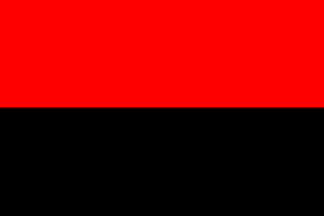 image by Ivan Sache, 3 June 2001
image by Ivan Sache, 3 June 2001
 image by Ivan Sache, 6 May 2021
image by Ivan Sache, 6 May 2021
Universidad Tecnológica de Bolívar (UTB) was established on 5 August 1970 in
Cartagena de Indias, the capital of Bolívar department, as Corporación
Universitaria Tecnológica de Bolívar. Classes started on 3 March 1971.
In
1975, five economic bodies registered as corporate partners of the university:
- the Colombian Entrepreneur's National Association (Asociación Nacional de
Empresarios de Colombia - ANDI)
- the Cartagena Chamber of Commerce
- the
Colombian Construction Chamber (Cámara Colombiana de la Construcción - CAMACOL);
- the Colombian Association of SMEs (Asociación Colombiana de Medianas y
Pequeñas Industrias - ACOPI)
- the National Commerce Federation (Federación
Nacional de Comerciantes - FENALCO).
In 2003, the Ministry of National
Education granted the institute the status of full university, to be renamed to
Universidad Tecnológica de Bolívar
UTB is composed of the Faculties of
Engineering, Business, Social Sciences and Humanities, Basic Sciences,
Education, and Economic Development and Sustainability.
https://www.utb.edu.co/
UTB website
The flag of UTB is diagonally divided white-green from the lower hoist to
the upper fly, with the university's symbol in the center.
Photos
https://www.elempleo.com/sitios-empresariales/colombia/unitecnologica/
https://erasmusu.com/es/erasmus-utb-universidad-tecnologica-de-bolivar
http://estudioenlanube.blogspot.com/2014/06/un-paseo-por-la-historia-informatica-de.html
https://www.facebook.com/utboficial/photos/2331285160311594
https://www.facebook.com/utboficial/photos/1871625759610872
https://www.facebook.com/utboficial/photos/1629738200466297
[For
whatever reason, the flag is erroneously presented on the university's website
as diagonally divided green-white.]
The symbol of UTB is green, a color
connected to freshness, renovation, Caribbean and coexistence.
Its element
convey a modern, educative, institutional and growing image in the Caribbean and
international context. Its shape, perspective and two-dimensionality highlight a
well-defined direction, solidity, development and steps of improvement.
The "U" represents the university's body, academic goals, professors, research,
and social commitment to a critic, flexible and global educative project. Th "U"
provides connection with the other institutions.
The "U" is also an inclusive
element, from which everything gushes forth. Its angular shape conveys a
direction, while its green center conveys solidity and graphic force.
The
royal palm is featured in the chief of the Republican coat of arms of Cartagena,
expressing pride for the past tradition and high security in the commitment for
the future.
Also an element proper to the Caribbean region, the palm
represents growth, solidity and adaptation to new winds. Its solid roots
represents permanence and force. Its transparency and contrast convey clarity,
sincerity and a new morning. Its placement in the symbol creates a new horizon:
The Caribbean region in the central axis, with projection to the world.
The circle is a basic framing element, representing the interacting world,
globalization and internationalization. The palm is placed in its center,
symbolizing the Caribbean perspective from Cartagena de Indias towards the
world.
The circle is also a concept of community, environmental
responsibility, and dynamic services.
The specification for the basis
green color is:
Pantone DS 277 - 2C
CMYK 85 28 87 15
RGB 35 31 32
The chromatic range to be used (% of the basic color) is:
Palm, right
part: 0% [white]
Palm, right part, circle and disc: 8%
Palm frame: 67%
Symbol background: 39%
Symbol frame: 18%
https://www.utb.edu.co/sites/web.unitecnologica.edu.co/files/descargas/MANUAL_DE_IDENTIDAD_CORPORATIVA.pdf
Manual de Identidad Corporativa, April 2013
Ivan Sache, 6
May 2021
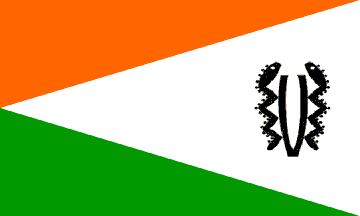 image by Carlos Thompson, 28 May 2003
image by Carlos Thompson, 28 May 2003
Translated from Universidad del Bosque (Bogota)
website at <www.unbosque.edu.co>:
"Using several schemas used for summarizing a few of the
program ideas, the flag was designed. A rectangle which two
oblique lines divide in three triangles: the upper and the lower
are rectangle (triangles) and in the middle another triangles
that is opening till it reaches the base and continues to the
infinity meaning the raising complexity of our studies, the
progressive increment of our knowledge that never ends. The
upper in orange color, the color of medicine, the lower in green
color symbol of hope, and the central white, sign of clean and
purity and in it the symbol".
Carlos Thompson, 28 May 2003
"Escuela Colombiana de Medicina" was recognized by
the Ministry of National Education on 4 August 1978 (Decree No.
11153) on the grounds of "Clínica El Bosque".
The institute was upgraded to a university by the Ministry of
National Education on 5 February 1997 (Decree No. 327).
The symbol of the university, shown on the right part of the
flag, was adopted in 1982. It is based on a Muisca artefact kept
in the Gold Museum of the National Bank as item No. 1990. Found
in Soacha and 15- cm high, the item represents a mace and two
snakes, probably belonging to a lord or a shaman. The artefact is
shown in the book by Antonio Grass, "Diseño precolombino
colombiano" (Bogotá, 1972).
Ivan Sache, 30 December 2008
 image by Ivan Sache, 27 June 2014
image by Ivan Sache, 27 June 2014
Colegio de Boyacá (Colboy) was established in Tunja (Boyacá Department) by
National Decree No. 55, signed on 17 May 1822 by General Francisco de Paula
Santander, the Vice President of the Republic, in charge of the Executive. This
Decree initiated state education in Colombia.
The institute was officially inaugurated on 20 October 1822 in the St. Augustine
convent, built from 1578 to 1659 and closed in 1821. The sermon initiating
teaching was given by the Franciscan friar Francisco Florido, parish priest of
Ramiriquí. The event was reported by the assessor Francisco Soto in an article
published on 17 November 1822 on the front page of the Gaceta de Colombia, No.
57. The predicator of the convent, Friar José Antonio Cháves (1787-1856) was
appointed the first director of the institute, which he ran from 1822 to 1823
and from 1826 to 1827. He was appointed Professor of Religious Fundaments,
Theology, Apologetic Religious Studies, Holy Book and Moral and Dogmatic
Theological Institutions at the Boyacá University by a Decree signed on 5
January 1828 by Simón Bolívar. The Chair of Civil Law, the first in the country,
was established on
21 May 1825 at Colegio de Boyacá. The Boyacá University was established by
National Decree of 30 May 1827, signed by General Francisco de Paula Santander;
according to the Decree signed on 5 January 1828 by Simón Bolívar, the
University and the Colegio would have the same Director and Deputy Director.
Ruled by the Augustine Fathers from 1830 to 1831, Colegio de Boyacá was
re-established as a state institute by the Provincial Decree of 22 October 1832.
The University and the Colegio were relocated in 1835 to the old Jesuit convent,
established in the first half o the 17th century. Transformed in 1880 into an
Agriculture Institute, Colegio de Boyacá was re-established in 1886. Renamed
Colegio Ricaurte in 1896, the institute eventually re-adopted its original name
in 1903. Among the alumni of the Colegio de Boyacá are several governors,
ministers, bishops and the Presidents of the Republic Mariano Ospina Rodríguez
(1857-1861), Santos Gutiérrez (1863; 1868-1870), Clímaco Calderón Reyes (21-22
December 1882), Rafael Reyes (1904-1909) and Gustavo Rojas Pinilla (1953-1957).
The flag of the institute is horizontally divided green-red-white. The flag is
derived of the flag of Boyacá, but with three, equal stripes instead of four,
unequal. Green is a symbol of faith, sincere friendship, commitment to service,
respect and hope in better days. Green represents also the fertility of the
fields and the underground rich in emeralds. White is a symbol of territorial
attachment, deep thoughts, dedication to intelligence and territorial unity. Red
is a symbol of the heroes who fought for independence and freedom during the
1819 Liberation Campaign. They fecundated with their generous blood the
greatness of Colombia and made of it an everlasting free republic.
Source:
http://www.colboy.edu.co/index.php?option=com_content&view=article&id=166&Itemid=54
- Institute's website
Photos:
http://www.colboy.edu.co/images/rsgallery/watermarked/ae1f5e75a12a5586b1f59035c62a6f4e.jpg
http://www.colboy.edu.co/images/rsgallery/watermarked/2555eb7f52fdb7d039bdf3e68fe54cfd.jpg
http://www.colboy.edu.co/images/rsgallery/watermarked/0066658e156aae7f2b1f844441972136.jpg
Ivan Sache, 27 June 2014
 image by Ivan Sache, 8 January 2019
image by Ivan Sache, 8 January 2019
Gimnasio Boyacá was established on 27 November 1945 in Bogotá by Tito
Tulio Roa Contreras. The school was acquired in 2009 by Universidad ECCI and
renamed to Gimnasio Boyacá ECCI.
The flag of Gimnasio Boyacá ECCI is
prescribed in Article 16 of the Manual de Convivencia, as composed of three
horizontal stripes, yellow, green and blue. These colors represent honor and
hope.
http://gimnasioboyacaecci.edu.co/home/wp-content/uploads/2017/02/Manual-de-convivencia-2017.pdf,
Manual de Convivencia
Ivan Sache, 8 January 2019
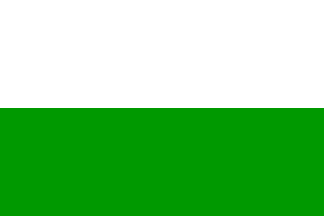 image by Ivan Sache, 20 November 2014
image by Ivan Sache, 20 November 2014
Escuela San Miguel, established on 16 February 1904 in Pereira (Risaralda
Department), was renamed Escuela Boyacá in 1938.
The flag of the institute is horizontally divided white-green. White is a symbol
of purity of the soul. Green is a symbol of the natural environment, of hope,
generosity and justice.
Source:
http://institucioneducativaboyaca.wordpress.com/nuestra-historia/ -
Institute's website
Ivan Sache, 20 November 2014
 image by Dov Gutterman, 21 July 2002
image by Dov Gutterman, 21 July 2002
Image based on <www.uniboyaca.edu.co>.
Dov Gutterman, 21 July 2002
The flag of Uniboyacá, as shown graphically and described on
the university's
website, is horizontally divided white-red-white. White
represents the spiritual world, including research, science,
education and all kinds of intellectual work. It represents also
the youth.
Red represents life in its permanent evolution and improvement,
the vital sap of our history and the symbol of our liberty.
The colours of the flag of Uniboyacá are the core of the flag of
the Department of Boyacá.
Ivan Sache, 27 December 2008
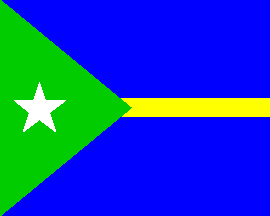 image by Ivan Sache, 18 January 2009
image by Ivan Sache, 18 January 2009
"Centro Educativo Distrital Britalia" is located in
the borough of Britalia, Bogotá.
The flag of the institute, as shown graphically on the website of the
institute, is blue with a thin yellow stripe in the middle
and a green triangle charged with a white star placed along the
hoist.
Ivan Sache, 18 January 2009
 image by Ivan Sache, 3 January 2021
image by Ivan Sache, 3 January 2021
Colegio Britanico was established on 8 February 1980 in Montería (Córdoba) by
Margarita Sanin de del Castillo.
The flag of Colegio Britanico is white
with then vertical stripes on the edges, green and gray respectively, and the
school's emblem in the center.
Photo
http://britanicomonteria.edu.co/historia
The emblem features the old
Gustavo Rojas Pinilla bridge, locally known as the iron bridge, spanning over
river Sinú. Deemed obsolete , the old bridge is expected to be substituted by a
brand new one but kept in use for pedestrians and light vehicles only.
https://larazon.co/monteria/gobierno-nacional-asumio-la-construccion-de-tercer-puente-sobre-el-sinu-en-monteria/
La Razón
Ivan Sache, 3 January 2021
 image by Ivan Sache, 27 October 2014
image by Ivan Sache, 27 October 2014
Escuela Normal Superior de Bucaramanga (Santander Department) was established
in 1975.
The flag of the institute is horizontally divided blue-white-golden yellow with
the institute's emblem in the middle.
Source:
https://sites.google.com/site/escuelanormalbucaramanga/ - Institute's
website
Ivan Sache, 27 October 2014
 image by Ivan Sache, 12 October 2018
image by Ivan Sache, 12 October 2018
IE Buenos Aires is located in borough Buenos Aires, Cúcuta (Norte de
Santander Department).
The flag of IE Buenos Aires is horizontally
divided green-white. Green is a symbol of hope placed by the school in each
student, whose actions shall define the future of the society. White represents
peace as a goal to live in harmony; it also represents God, source and author of
peace.
https://colbuenosaires.edu.co/portal/nuestro-colegio/simbolos/
School
website
Ivan Sache, 12 October 2018
 image by Ivan Sache, 01 December 2014
image by Ivan Sache, 01 December 2014
Instituto Técnico Agrícola Buga is located in Gudalajara de Buga
(Valle Department).
The flag of the institute is horizontally divided white-green with the
institute's emblem in the middle.
White is a symbol of rectitude, empowerment and good faith.
Green is a symbol of agriculture, cattle-breeding and of natural
environment; it is also the symbol of aspiration to a better future.
The emblem of the institute is symmetrical, emphasizing the different
trends and dimensions of education. Letter "P" stands for
"Profesionales". Letter "T" stands for Technology; the style of the
"T" expresses the power of the academic programs.
Source: http://www.ita.edu.co/index.php/institucion/simbolos - Institute's
website
Ivan Sache, 01 December 2014